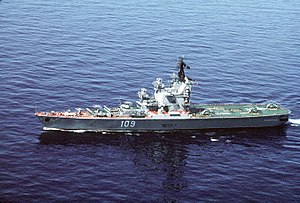 Leningrad underway in 1990
| |
| History | |
|---|---|
| Name | Leningrad |
| Namesake | Leningrad |
| Builder | Nikolayev South (Shipyard No.444) |
| Laid down | 15 January 1965 [1] |
| Launched | 31 July 1966 [1] |
| Commissioned | 2 June 1969 [1] |
| Decommissioned | 24 June 1991 |
| Fate | Scrapped 1995 |
| General characteristics | |
| Class and type | Moskva-class helicopter carrier |
| Displacement | |
| Length | 189.0 m (620 ft 1 in)[1] |
| Beam | 34.0 m (111 ft 7 in)[1] |
| Draught | 7.7 m (25 ft 3 in)[1] |
| Propulsion | 2 shaft steam turbines, 4 pressure fire boilers, 100,000 hp (75,000 kW) |
| Speed | 31 knots (57 km/h; 36 mph) |
| Range | 14,000 nmi (26,000 km; 16,000 mi) at 12 knots (22 km/h; 14 mph) |
| Complement | 850 |
| Armament |
|
| Aircraft carried | 14 Ka-27 'Helix' helicopters |
Leningrad was the second of two Moskva-class helicopter carriers in service with the Soviet Navy. Laid down at Nikolayev South (Shipyard No.444), Leningrad was commissioned in late 1968. Preceded by Moskva, there were no further vessels built, reportedly due to the poor handling of the ships in rough seas. She was conventionally powered.
- ^ a b c d e f g h "Project 1123". Archived from the original on April 4, 2013. Retrieved January 29, 2013.